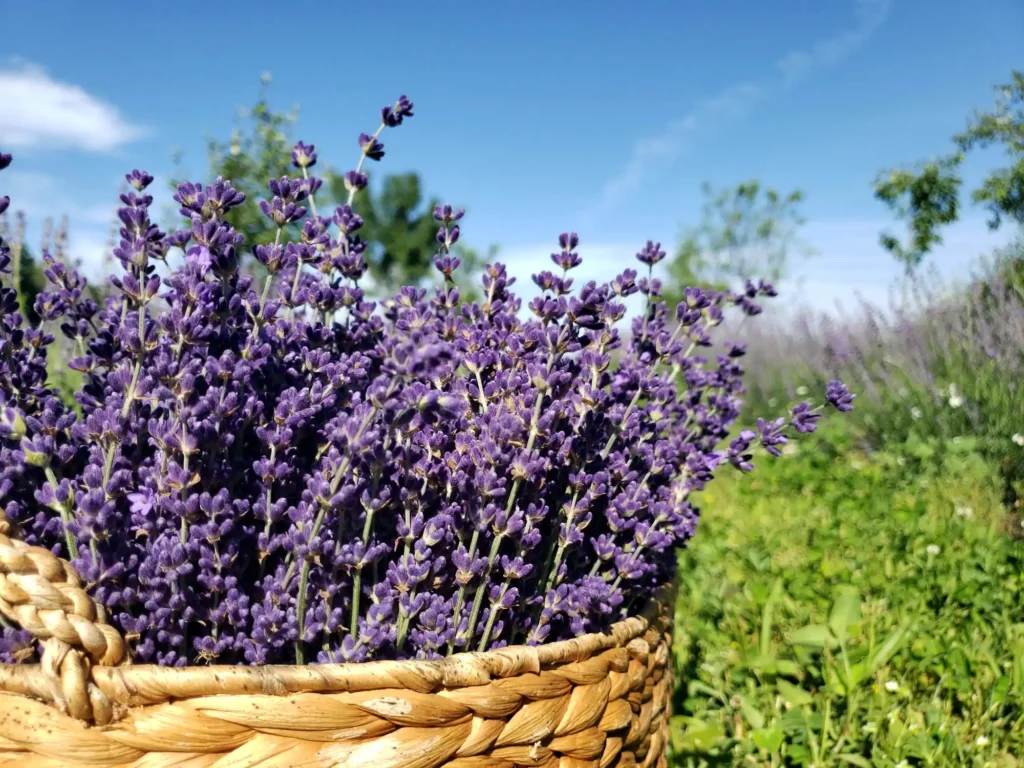Your cart is currently empty!
FAQ’s
Here are some frequently asked questions about lavender, focusing on Lavandula angustifolia (English lavender) and Lavandula x intermedia (Lavandin),

What are the different types of lavender?
There are many different types of lavender, but some of the most popular include English lavender (Lavandula angustifolia), French lavender (Lavandula dentata), and Spanish lavender (Lavandula stoechas). Each type has its own unique characteristics, such as flower color, fragrance, and growth habit.
What are the main differences between English lavender (Lavandula angustifolia) and Lavandin (Lavandula x intermedia)?
Size and Growth: English lavender is generally more compact, reaching heights of 1-3 feet. Lavandin is larger and more vigorous, growing 2-5 feet tall.
Flower Spikes: English lavender has shorter, more delicate flower spikes. Lavandin produces longer, more abundant spikes.
Scent: Both have the characteristic lavender scent, but English lavender is considered to have a sweeter, more floral aroma, while Lavandin’s scent is stronger and more camphorous, due to its higher camphor content.
Oil Production: Lavandin produces significantly more essential oil than English lavender, making it preferred for commercial oil production.
Hardiness: English lavender is generally more cold-hardy than Lavandin, although specific cultivars vary.
Propagation: English lavender can be propagated by seed or cuttings. Lavandin, being a hybrid, is usually propagated by cuttings as its seeds are often sterile.
Which lavender is the most fragrant?
English lavender is generally considered to be the most fragrant type of lavender. It has a sweet, floral scent that is often used in perfumes and aromatherapy.
Which lavender is best for cooking and baking?
English lavender (Lavandula angustifolia) is the most popular type of lavender for cooking. It has a sweet, floral flavor that pairs well with both sweet and savory dishes. Use it sparingly, as its flavor can be potent. Lavender is used in teas, baked goods, jams, and even savory dishes like roasted lamb or chicken. Lavandin is generally not recommended for culinary use due to its higher camphor content. There are some exceptions to this, such as the lavandin cultivar ‘Gros Bleu,’ widely regarded as perfectly suitable for culinary uses.
What are the best lavender varieties for different climates?
Cold Climates: For colder regions, look for Lavandula angustifolia varieties like ‘Folgate,’ Lodden Blue,’ or ‘Royal Velvet’, known for their hardiness. There are lavandin varieties that are also cold hardy. We currently have the lavandin cultivars ‘Grosso’ and ‘Gros Bleu’ that are doing just fine in Michigan (hardiness zone 6a).
Hot and Humid Climates: Lavandin varieties like ‘Grosso’ and ‘Provence’ are more tolerant of heat and humidity. Lavandula x intermedia ‘Phenomenal’ is known for its exceptional hardiness and heat tolerance.
Container Gardening: Smaller English lavender varieties like ‘Imperial Gem’ or ‘Melissa’ are well-suited for containers.
How do I grow lavender successfully?
Lavender is a relatively easy plant to grow, but it does require some specific conditions. It needs full sun, well-drained soil, and watering. Lavender is also drought-tolerant once it is established. Lavender thrives in full sun (at least 6-8 hours daily) and well-drained soil. It prefers slightly alkaline to neutral soil. While all plants need water, avoid overwatering your lavender, as this can lead to root rot. Water deeply but infrequently, allowing the soil to dry out between waterings. Pruning is essential for maintaining shape and encouraging new growth. Amend the soil with compost or other organic matter to improve drainage and fertility.
Can lavender grow in shade?
Lavender cannot grow in shade. It needs at least 6 hours of sunlight per day to thrive.
Can lavender grow in pots?
Yes, lavender can grow in pots. However, it is important to choose a pot that is large enough to accommodate the plant’s roots. Ensure that the pot has adequate drainage holes to prevent the soil from becoming waterlogged.
Can I bring my lavender indoors?
Yes, you can bring your lavender indoors. However, it is important to provide it with enough sunlight. Lavender can also be grown indoors under grow lights.
What are some common lavender pests and diseases?
Lavender is relatively pest-resistant, but it can be susceptible to:
Root Rot: Caused by overwatering and poor drainage.
Fungal Diseases: Can be prevented by ensuring good air circulation.
Aphids: Can be treated with insecticidal soap.
Whiteflies: Can be controlled with sticky traps or insecticidal soap.
How do I propagate lavender?
Cuttings: This is the most reliable method, especially for Lavandin. Take cuttings from new growth in spring or early summer. Remove the lower leaves and dip the cut end in rooting hormone before planting in a well-draining potting mix.
Seed: English lavender can be grown from seed, but it can be slow and may not produce identical offspring to the parent plant.
Why is my lavender not blooming?
Several factors can contribute to a lack of blooming: insufficient sunlight, overwatering, poor soil drainage, lack of pruning, or too much fertilizer (which can encourage foliage growth at the expense of flowers). Ensure your lavender is getting at least 6-8 hours of sun, the soil drains well, and you are pruning it correctly.
Why is my lavender dying?
There are several reasons why your lavender might be dying. Some of the most common reasons include overwatering, underwatering, and lack of sunlight. Lavender can also be susceptible to root rot and other diseases.
When and how should I prune lavender?
Pruning lavender is crucial. For both English and Lavandin, a light pruning can be done after the first flush of flowers, removing spent flower stalks. A more significant pruning should be done in late summer or early fall, before the first frost. Avoid pruning into the woody part of the plant, as this can hinder regrowth. Shape the plant into a rounded mound, removing about one-third of the current year’s growth.
When does lavender bloom?
Lavender blooms in the summer. The exact time of blooming will vary depending on the type of lavender and the climate. English lavender typically blooms in late June or early July (with many cultivars blooming lightly again in fall), while lavandin typically blooms mid to late July and early August.
How do I harvest and dry lavender?
Harvest lavender when 30-50% of the flower buds have opened, and the color is at its peak. Cut the stems long and bundle the stems together with a rubber band. Hang them upside down in a cool, dark, and well-ventilated area. Allow them to dry for several weeks. Once dry, you can gently remove the buds and flowers from the stems and store them in an airtight container.
Is lavender safe for cats and dogs?
Lavender contains compounds that can be toxic to pets (dogs and cats) if ingested in large quantities. While small amounts may not cause serious harm, it’s best to keep lavender plants out of reach of pets. Symptoms of lavender toxicity in pets can include vomiting, diarrhea, and lethargy.
